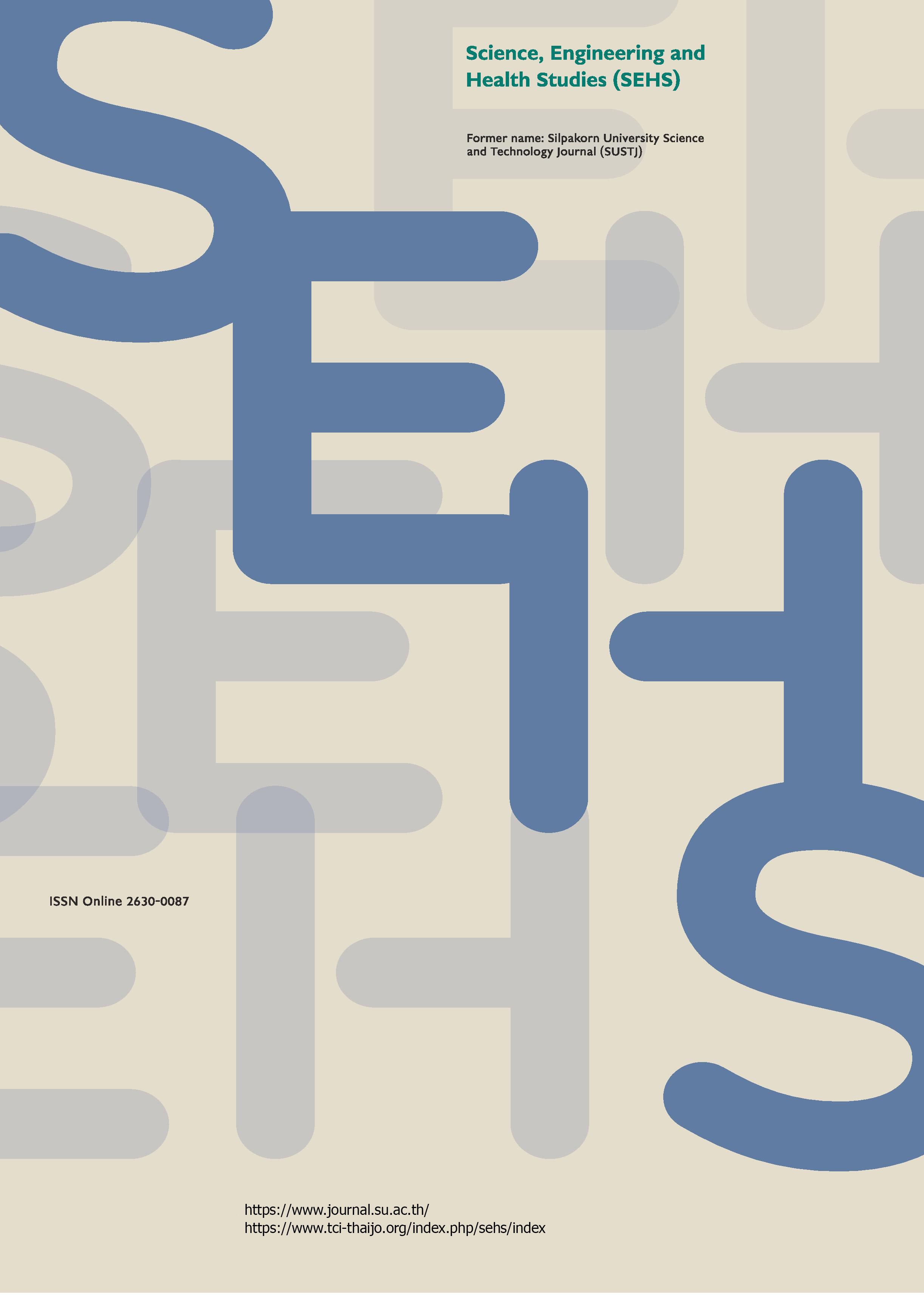Optimization of nanocrystalline cellulose particle size using one-factor-at-a-time method under different acid hydrolysis parameters
Main Article Content
Abstract
This study explores the production of nanocrystalline cellulose (NCC) from corn cob (Zea mays), aiming to overcome the challenges of carbonization and reduced yield typically associated with the use of highly concentrated and corrosive sulfuric acid. A systematic approach was adopted employing one-factor-at-a-time analysis to optimize the hydrolysis process, focusing on three key parameters: sulfuric acid concentration, hydrolysis temperature, and duration. The determination of optimized conditions was based on the desired particle size of the NCC produced and the absence of carbonization. The produced NCC was thoroughly characterized using Fourier transform infrared spectroscopy to determine its chemical structure, X-ray diffraction for crystallinity, and thermogravimetric analysis (TGA) for thermal properties. The results highlighted that the optimal conditions for NCC production involve a sulfuric acid concentration of 40 wt% at a temperature of 70 °C, with a hydrolysis duration of 150 min. These conditions yielded NCC with a uniform particle size of 225.07 nm, no signs of carbonization, and a significantly lower inorganic content at 6.73 w/w% after heating to 590 °C in the TGA. This study thereby offers valuable insights for producing NCC with reduced carbonization and increased yield.
Downloads
Article Details

This work is licensed under a Creative Commons Attribution-NonCommercial-NoDerivatives 4.0 International License.
References
Adawiyah, R., Suryanti, V., and Pranoto. (2022). Preparation and characterization of microcrystalline cellulose from lembang (Typha angustifolia L.). Journal of Physics: Conference Series, 2190, 012007.
Adriana, A., Saifuddin, S., and Jalal, R. (2020). Production and characterization of nanocrystalline cellulose from palm empty fruit bunch fiber. IOP Conference Series: Materials Science and Engineering, 732, 012006.
Azeredo, H. M. C., Rosa, M. F., and Mattoso, L. H. C. (2017). Nanocellulose in bio-based food packaging applications. Industrial Crops and Products, 97, 664–671.
Boukir, A., Fellak, S., and Doumenq, P. (2019). Structural characterization of Argania spinosa Moroccan wooden artifacts during natural degradation progress using infrared spectroscopy (ATR-FTIR) and X-Ray diffraction (XRD). Heliyon, 5(9), e02477.
Burra, K. G., Daristotle, N., and Gupta, A. K. (2021). Carbonization of cellulose in supercritical CO2 for value-added carbon. Journal of Energy Resources Technology, 143(7), 072105.
Chen, Y. W., Lee, H. V., Juan, J. C., and Phang, S.-M. (2016). Production of new cellulose nanomaterial from red algae marine biomass Gelidium elegans. Carbohydrate Polymers, 151, 1210–1219.
Fahma, F., Iwamoto, S., Hori, N., Iwata, T., and Takemura, A. (2010). Isolation, preparation, and characterization of nanofibers from oil palm empty-fruit-bunch (OPEFB). Cellulose, 17(5), 977–985.
Fortunati, E., Puglia, D., Monti, M., Peponi, L., Santulli, C., Kenny, J. M., and Torre, L. (2013). Extraction of cellulose nanocrystals from Phormium tenax fibres. Journal of Polymers and the Environment, 21(2), 319–328.
Franco, T. S., Potulski, D. C., Viana, L. C., Forville, E., de Andrade, A. S., and de Muniz, G. I. B. (2019). Nanocellulose obtained from residues of peach palm extraction (Bactris gasipaes). Carbohydrate Polymers, 218, 8–19.
Grande, R., Trovatti, E., Carvalho, A. J. F., and Gandini, A. (2017). Continuous microfiber drawing by interfacial charge complexation between anionic cellulose nanofibers and cationic chitosan. Journal of Materials Chemistry A, 5(25), 13098–13103.
Han, S., Bai, L., Chi, M., Xu, X., Chen, Z., and Yu, K. (2022). Conversion of waste corn straw to value-added fuel via hydrothermal carbonization after acid washing. Energies, 15(5), 1828.
Heidarian, P., Behzad, T., and Karimi, K. (2016). Isolation and characterization of bagasse cellulose nanofibrils by optimized sulfur-free chemical delignification. Wood Science and Technology, 50(5), 1017–1018.
Heidarinejad, Z., Dehghani, M. H., Heidari, M., Javedan, G., Ali, I., and Sillanpää, M. (2020). Methods for preparation and activation of activated carbon: a review. Environmental Chemistry Letters, 18(2), 393–415.
Ishida, O., Kim, D.-Y., Kuga, S., Nishiyama, Y., and Brown, R. M. (2004). Microfibrillar carbon from native cellulose. Cellulose, 11, 475–480.
Ma, Z., Pan, G., Xu, H., Huang, Y., and Yang, Y. (2015). Cellulosic fibers with high aspect ratio from cornhusks via controlled swelling and alkaline penetration. Carbohydrate Polymers, 124, 50–56.
Naduparambath, S., Jinitha T. V., Shaniba, V., Sreejith, M. P., S., Balan, A. K., and Purushothaman, E. (2018). Isolation and characterisation of cellulose nanocrystals from sago seed shells. Carbohydrate Polymers, 180, 13–20.
Pandey, S. (2017). A comprehensive review on recent developments in bentonite-based materials used as adsorbents for wastewater treatment. Journal of Molecular Liquids, 241, 1091–1113.
Sumaila, A., Ndamitso, M. M., Iyaka, Y. A., Abdulkareem, A. S., Tijani, J. O., and Idris, M. O. (2020). Isolation and characterization of selected biopolymers from Maize Cobs and Crab Shells obtained in Niger State, Nigeria. Research Journal of Material Sciences, 8(1), 19–23.
Tang, M. M., and Bacon, R. (1964). Carbonization of cellulose fibers—I. low temperature pyrolysis. Carbon, 2(3), 211–214.
Thomas, B., Raj, M. C., Athira, K. B., Rubiyah, M. H., Joy, J., Moores, A., Drisko, G. L., and Sanchez, C. (2018). Nanocellulose, a versatile green platform: From biosources to materials and their applications. Chemical Reviews, 118(24), 11575–11625.
Wang, Z., Yao, Z., Zhou, J., and Zhang, Y. (2017). Reuse of waste cotton cloth for the extraction of cellulose nanocrystals. Carbohydrate Polymers, 157, 945–952.
Yao, W., Weng, Y., and Catchmark, J. M. (2020). Improved cellulose X-ray diffraction analysis using Fourier series modeling. Cellulose, 27, 5563–5579.


